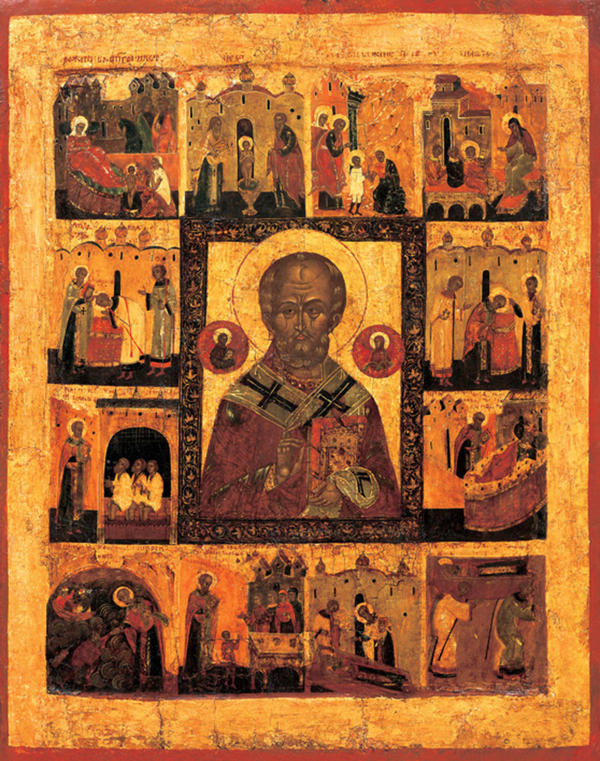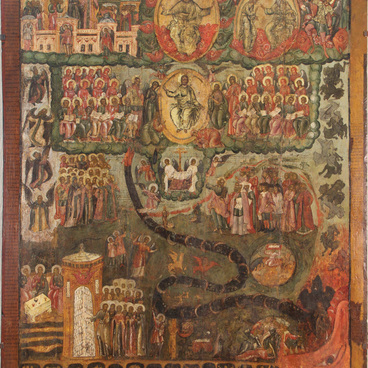1 / 3
The Hagiographical Icon of St. Nicholas
Creation period
Late 16th – early 17th century
Dimensions
64x50,7 cm
64х50.7х3 cm
64х50.7х3 cm
Technique
Wood, tempera
Exhibition
1
Open in app#1

Unknown author
The Hagiographical Icon of St. Nicholas
#3
#2
Nicholas the Wonderworker lived in the 3rd century A.D. in the time of persecution against Christians. He was the Archbishop of the city of Myra in the Roman province of Lycia. The then Roman Emperor Diocletian ordered to seize him, cast into jail and torture until he repudiates his Christian faith. In the year 324, Flavius Valerius Aurelius Constantine became the Roman Emperor. He made Christianity the main religion and released Nicholas from prison.
St. Nicholas distinguished himself with his wonders: he raised from the dead a drowned sailor; appeared in the dream of the Emperor and convinced him not to execute the erroneously convicted; healed the sick ones. Christians began to worship St. Nicholas the Wondermaker way back in the 4th century, soon after his death. The cult of this Saint also spread over Russia. The earliest icon of St. Nicholas dates back to the 11th century and is kept in the St. Sophia Cathedral in Kiev.
St. Nicholas distinguished himself with his wonders: he raised from the dead a drowned sailor; appeared in the dream of the Emperor and convinced him not to execute the erroneously convicted; healed the sick ones. Christians began to worship St. Nicholas the Wondermaker way back in the 4th century, soon after his death. The cult of this Saint also spread over Russia. The earliest icon of St. Nicholas dates back to the 11th century and is kept in the St. Sophia Cathedral in Kiev.
#4
Iconography
#5
Three types of icons have been established in Russia. The full-length icon of St. Nicholas of Myra with the Gospels is called St. Nicholas of Zaraisk. Another full-length icon if St. Nicholas of Mozhaisk, but instead of the Gospels, the Saint is holding a sword and a city tower. The third type is a chest-length image called St. Nicholas of Myra. It shows the chest-length image of the Wonderworker with two medallions, of Jesus and Virgin Mary, at the top.
The icon from the State Museum of Fine Arts of Khanty-Mansiysk is of the third iconographic type: the image of the Saint is surrounded with border scenes with episodes of his life. Such an icon is called the hagiographical icon.
The icon from the State Museum of Fine Arts of Khanty-Mansiysk is of the third iconographic type: the image of the Saint is surrounded with border scenes with episodes of his life. Such an icon is called the hagiographical icon.
#6
The image is surrounded with 12 border scenes of the life of St. Nicholas of Myra: nativity, learning to read and to write, the initiation to the Deacon, the ordainment to the Bishop, the dormition of St. Nicholas and translation of his relics from Myra to Bari. Among the 12 scenes there also are his wonders: appearance of St. Nicholas in the dream of Emperor Constantine, saving Demetrius the Sailor from drowning, healing of a woman with a withered arm, returning home kidnapped Basil.
#7
Technique
#8
Icon painting technique in the territory around the Onega lake did not differ from that of other regions. Icons were painted on a wooden plate with a special cut-back center portion with a flat bottom where the main image was painted. The work on the item was staged: first, a thin linen cloth was glued to the wood panel, then it was coated with a primer: a mix of chalk, glue and oil, and after that the images of Saints were painted.
#9
The icon was kept in the collection of the St. Petersburg philanthropist Viktor Samsonov. In 1996 the icon was transferred to the Generations Fund of the Khanty-Mansi Autonomous District. In 2011 it was handed over to the the State Museum of Fine Arts of Khanty-Mansiysk.
#10
State Museum of Fine Arts of Khanty-Mansiysk
read morehide
00:00
00:00
1x
The Hagiographical Icon of St. Nicholas
Creation period
Late 16th – early 17th century
Dimensions
64x50,7 cm
64х50.7х3 cm
64х50.7х3 cm
Technique
Wood, tempera
Exhibition
1
Open in app
Share




